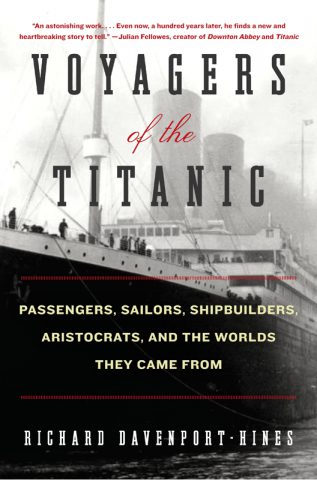As any New Yorker will tell you, moving stinks—from packing endless boxes to carrying furniture up a five-floor walkup. Now imagine moving to a new country with a few paltry possessions and a half-promise of a job, leaving all your loved ones an ocean behind. That’s just one of the stories you’ll find in Voyagers of the Titanic by Richard Davenport-Hines, one of an armload of volumes published in time to coincide with the centennial of the Titanic’s sinking.
Voyagers of the Titanic begins in an unusual place, and one can almost feel the doom in Davenport-Hines’ words. For reasons now clear, the ship was ill-fated when first setting sail and – knowing what we all know – you almost want to warn the passengers as you’re reading.
One hundred winters ago, Arctic temperatures were milder than normal, which created a greater number of icebergs calving off the glaciers near Greenland’s coast. These bergs floated on currents into the open ocean, right into shipping lanes for cargo vessels and luxury liners.
One of the liners was the Titanic. Eleven stories high, weighing nearly 47,000 pounds, she carried 2,240 passengers and crew, gems and spices, books, a car, fine fabric, mail and more. There were fine dining rooms onboard, a swimming pool, library and quarters for pampered first-class dogs.
Davenport-Hines then describes each group of people on the Titanic, and there are even further surprises here. Her captain, Edward John Smith, was on the verge of retirement. Most of the crew of the Titanic was new to this ship, although they were an experienced lot of stewards, linen keepers, waiters and a slew of men whose backbreaking job was to fill 190 steel furnaces with coal every 20 minutes.
Third class passengers, mostly northern European working folk, constituted most of those onboard. Second-class passengers were middle-class merchants and small business owners. Among them was the only black man on board. First class passengers were the kind who might board the Titanic on a whim, or just as quickly cancel the trip to pursue another fancy. Some of them did so, like Titanic’s owner, J.P. Morgan. Others, tragically, did not, such as American tycoons John Jacob Astor IV and Benjamin Guggenheim.
In the next few weeks, you may be especially tempted to relive the Titanic story (try to avoid seeing the James Cameron film for the tenth time, for pity’s sake!). Instead, be moved by the Voyagers of the Titanic.


What Do You Think?